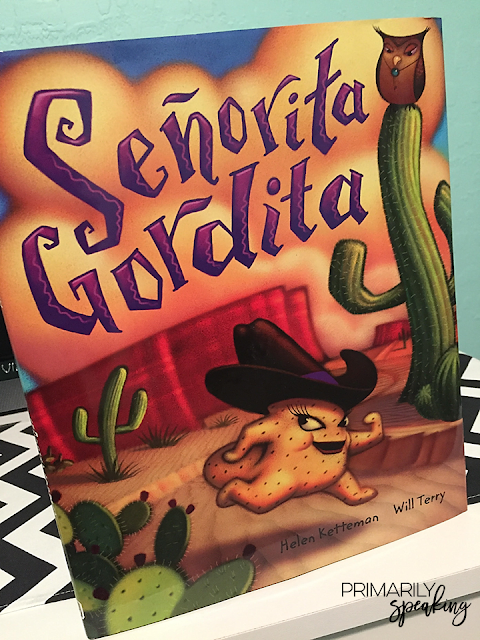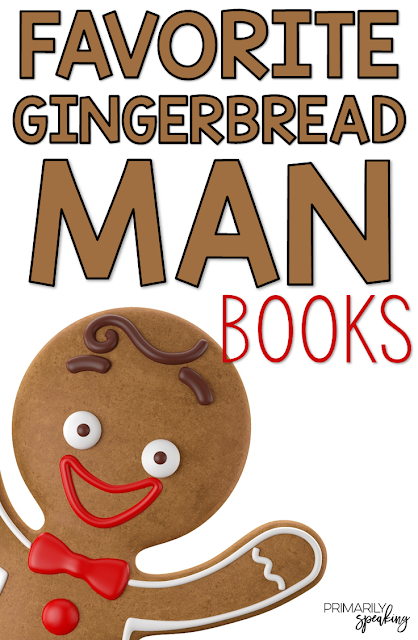My Favorite Gingerbread Books
I am a sucker for The Gingerbread Man. Really, I am. I love this story and all the different versions out there. Not only is it a fun story, but it is perfect for working on things like retelling, comparing and contrasting, character analysis, and more!
December is my favorite time to share this favorite with my students. Of course, I have several favorite versions on this story. I tend to vary the ones I use from year to year, but I love having options.
This post contains affiliate links for your shopping convenience. I earn a small commission each time someone makes a purchase through one of my links. For more information about my Disclosure Policy, please visit this link.
Let's start with the traditional versions of the story. I love these three. When kicking off my Gingerbread Man unit, I always read one of these first.
The Gingerbread Man (yellow cover)
The Gingerbread Boy
The Gingerbread Man (brown cover)
Each of these is a fairly standard version of the story. I like to use these traditional versions to practice our retelling skills. Focusing on the book in this manner helps the students to really think about the story, which prepares them to do some compare and contrast when we read different versions like the ones shown below.
The Gingerbread Girl
In this version, the starring role goes to a gingerbread girl. She is quick and sassy, just like her brother who was eaten before her. She gets chased by several different characters, but she gets away from every single one of them. As the story progresses, we learn that she is much smarter than her brother because she is able to outsmart that tricky fox!
The Gingerbread Bear
I seriously love this story. The cookie in this story is a bear who makes his way through Woodlands National Park. The bear is quick and gets away from several characters including some campers, a squirrel, and a wolf who chase after him, but eventually, he goes up against a park ranger....and loses.
The Ninjabread Man
In this story, a sensei bakes a special ninjabread treat (a gingerbread ninja). The Ninjabread Man comes to life and tells the sensei that it is time that his students put their skills to the test by trying to catch him. Then, he runs away. After sensei signals the gong, his students approach the Ninjabread Man one by one. The little cookie escapes every time, until (you've probably guessed it), he meets the fox, who outsmarts him. The book also includes a small glossary and a recipe for ninjabread cookies.
The Gingerbread Pirates
This story is so fun, but also completely different than the traditional story. You won't find any chases in this book. A boy and his mom make a crew of gingerbread pirates. The gingerbread pirate captain (with a toothpick peg leg) goes in search of his pirate crew to rescue them from the scary "cannibal" known as Santa Claus who is known for eating cookies just like them.When they meet Santa, he swears he won't eat them. It's full of fun and adventure.
It's also fun to read a few multicultural versions of the story too!
The Matzo Ball Boy
This story is a spin off of the traditional gingerbread man story. It is a rather long story, but it's filled with humor. It includes various Yiddish words, but there is a glossary (and pronunciation guide) in the back of the book to help you explain them to your students.
The Sourdough Man
In this story, a loaf of Alaskan sourdough comes to life. He is quick and runs away from various animals of the tundra. He encounters a musk ox, a lemming, a hare, a caribou, and more. None of these animals is a match for the Sourdough Man. Well, until he meets the arctic fox, anyway. The back of the book gives a bit of history about Alaska's sourdough past and also includes directions for making your own sourdough starter.
I recently added this one to my collection, and I can't wait to share it with my students.
Senorita Gordita
Senorita Gordita is a little runaway corn cake. She is "zip-zoom-fast" as she runs through the desert. She encounters different desert animals including (but not limited to) a snake, a scorpion, and a lizard, but she gets away from all of them. Sadly, she eventually meets an owl who outsmarts her and gobbles her up. There are several words in Spanish including the characters' names, but each term is defined in the back of the book. You can also find a recipe for gorditas in the back of the book. Yum!
Any version of this story makes it super easy to work on important reading skills such as retelling, comparing and contrasting, and analyzing characters. It's also easy to incorporate some writing by having students pick a favorite version and explain their reasoning. They could even write their own version of the story, or have them get creative and write about how to catch a gingerbread man. Sometimes, they come up with some pretty clever ideas!
Want to see how your students would catch a gingerbread man? Then be sure to grab the free templates shown above by clicking HERE.
Looking for other gingerbread man resources? Then, be sure to check out my Gingerbread Man unit on TPT. It was created for use with any version of the story and covers a variety of skills like the ones shown below. Not only is it educational, but it's fun and engaging. You can check out the complete unit HERE.
DON'T FORGET IT, PIN IT!

December is my favorite time to share this favorite with my students. Of course, I have several favorite versions on this story. I tend to vary the ones I use from year to year, but I love having options.
This post contains affiliate links for your shopping convenience. I earn a small commission each time someone makes a purchase through one of my links. For more information about my Disclosure Policy, please visit this link.
Let's start with the traditional versions of the story. I love these three. When kicking off my Gingerbread Man unit, I always read one of these first.
The Gingerbread Man (yellow cover)
The Gingerbread Boy
The Gingerbread Man (brown cover)
Each of these is a fairly standard version of the story. I like to use these traditional versions to practice our retelling skills. Focusing on the book in this manner helps the students to really think about the story, which prepares them to do some compare and contrast when we read different versions like the ones shown below.
The Gingerbread Girl
In this version, the starring role goes to a gingerbread girl. She is quick and sassy, just like her brother who was eaten before her. She gets chased by several different characters, but she gets away from every single one of them. As the story progresses, we learn that she is much smarter than her brother because she is able to outsmart that tricky fox!
The Gingerbread Bear
I seriously love this story. The cookie in this story is a bear who makes his way through Woodlands National Park. The bear is quick and gets away from several characters including some campers, a squirrel, and a wolf who chase after him, but eventually, he goes up against a park ranger....and loses.
The Ninjabread Man
In this story, a sensei bakes a special ninjabread treat (a gingerbread ninja). The Ninjabread Man comes to life and tells the sensei that it is time that his students put their skills to the test by trying to catch him. Then, he runs away. After sensei signals the gong, his students approach the Ninjabread Man one by one. The little cookie escapes every time, until (you've probably guessed it), he meets the fox, who outsmarts him. The book also includes a small glossary and a recipe for ninjabread cookies.
The Gingerbread Pirates
This story is so fun, but also completely different than the traditional story. You won't find any chases in this book. A boy and his mom make a crew of gingerbread pirates. The gingerbread pirate captain (with a toothpick peg leg) goes in search of his pirate crew to rescue them from the scary "cannibal" known as Santa Claus who is known for eating cookies just like them.When they meet Santa, he swears he won't eat them. It's full of fun and adventure.
It's also fun to read a few multicultural versions of the story too!
The Matzo Ball Boy
This story is a spin off of the traditional gingerbread man story. It is a rather long story, but it's filled with humor. It includes various Yiddish words, but there is a glossary (and pronunciation guide) in the back of the book to help you explain them to your students.
The Sourdough Man
In this story, a loaf of Alaskan sourdough comes to life. He is quick and runs away from various animals of the tundra. He encounters a musk ox, a lemming, a hare, a caribou, and more. None of these animals is a match for the Sourdough Man. Well, until he meets the arctic fox, anyway. The back of the book gives a bit of history about Alaska's sourdough past and also includes directions for making your own sourdough starter.
I recently added this one to my collection, and I can't wait to share it with my students.
Senorita Gordita
Senorita Gordita is a little runaway corn cake. She is "zip-zoom-fast" as she runs through the desert. She encounters different desert animals including (but not limited to) a snake, a scorpion, and a lizard, but she gets away from all of them. Sadly, she eventually meets an owl who outsmarts her and gobbles her up. There are several words in Spanish including the characters' names, but each term is defined in the back of the book. You can also find a recipe for gorditas in the back of the book. Yum!
Any version of this story makes it super easy to work on important reading skills such as retelling, comparing and contrasting, and analyzing characters. It's also easy to incorporate some writing by having students pick a favorite version and explain their reasoning. They could even write their own version of the story, or have them get creative and write about how to catch a gingerbread man. Sometimes, they come up with some pretty clever ideas!
Want to see how your students would catch a gingerbread man? Then be sure to grab the free templates shown above by clicking HERE.
Looking for other gingerbread man resources? Then, be sure to check out my Gingerbread Man unit on TPT. It was created for use with any version of the story and covers a variety of skills like the ones shown below. Not only is it educational, but it's fun and engaging. You can check out the complete unit HERE.
DON'T FORGET IT, PIN IT!

Share It:




























































